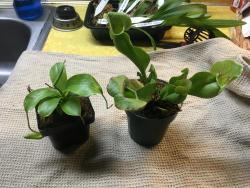The package instructions are wrong. First, do NOT grow them indoors, even in a sunny window.
They need at least 4 hours of direct sunlight per day - more they get, the better. If you can put them in the middle of your yard where they will get direct sunlight from sunrise to sunset, they will love it.
Temperatures do not matter much, as long at they are kept above about 40 deg F during the growing season. On the high end, occasional days over 100 deg F will not hurt the plants. Think zone 8, which is what they see in their native habitat.
Venus flytraps do not like to be quite as wet as most of the other carnivorous plants. They like thoroughly damp media, but not being soggy wet. I like to grow them in a standard 5" or larger pot. I even have some growing in a tall 10" pot. The larger/taller pots encourage longer root growth.
Flytraps will grow in pure peat moss, but I think there is less risk of fungus/mold if you use a mix of roughly 50:50 peat/perlite or 50:50 peat/horticultural sand. I prefer perlite, since the pots weigh less.
I leave them outdoors sitting in their water tray (kiddy wading pools - with a drain hole 3" up from the bottom) year around. I don't bother to protect them when it gets below freezing, although I should do so when the temperature gets below about 20 deg F. A couple of winters ago, they survived several nights of -5 deg F just fine.
